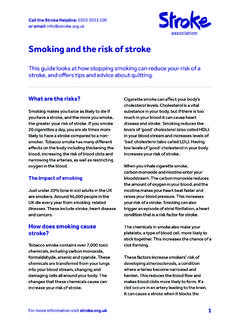Transcription of The Nurse–Patient Relationship - Jones & Bartlett Learning
1 Section TwoThe Nurse Patient 5722/05/13 7:10 PM Jones & Bartlett Learning , LLC. NOT FOR SALE OR 5822/05/13 7:10 PM Jones & Bartlett Learning , LLC. NOT FOR SALE OR DISTRIBUTIONC hapter F iveEstablishing a Therapeutic RelationshipLisa Kennedy Sheldon Rob Marmion/ShutterStock, 5922/05/13 7:10 PM Jones & Bartlett Learning , LLC. NOT FOR SALE OR DISTRIBUTION Case studySusan R. is a 38-year-old woman coming into the outpatient surgery center for a breast biopsy. She sits in the waiting room with her husband and is obviously nervous staring unblinking at the wall, tapping her feet, and wringing a tissue in her hand. The perioperative nurse approaches Susan to introduce herself and bring her into the operation suite to prepare for : Mrs. R., I am Laurie Snow, and I will be the nurse working with you today. What do you like to be called? Patient: Hello. Call me Sue; that s what everyone else calls me. This is my husband, Andrew.
2 Nurse: (She shakes hands with the patient and her husband.) It s nice to meet both of you. Sue, I would like to explain what s going to happen today, get a little more information from you, and answer any questions that you may have about the surgery. Patient: Oh, thank you. I am so scared. I don t know how I am going to get through this. Nurse: It s common to feel nervous about surgery. My goal is to help you through today. I will explain everything as we go along and answer any questions you and Andrew may have. Patient: I am glad that you will be there. May my husband come with me? Nurse: Of course. IntroductionIn a few moments, the perioperative nurse in the case study has accomplished a great deal toward creating a solid nurse patient Relationship . What did she do?1. Identified herself by Established her credentials and her Greeted the patient by her preferred Addressed both the patient and her husband by their preferred Reflected and normalized the patient s response to the Offered her assistance in relieving the patient s anxiety by explaining her Acknowledged that the patient might have questions and she was there to communication skills make the difference between average and excel-lent nursing care.
3 The therapeutic Relationship between the patient and the nurse Chapter Five establishing a therapeutic 6022/05/13 7:10 PM Jones & Bartlett Learning , LLC. NOT FOR SALE OR DISTRIBUTION forms the foundation of nursing care throughout the spectrum of health, illness, healing, and recovery. Some nurse patient relationships, such as the one in this example, last only a few hours; others, however, may last days, months, or even years. What is exciting about each Relationship is how unique and enriching it can be for both the patient and the underlying principles of the therapeutic Relationship are the same regardless of the length of the contact: respect, genuineness, empathy, active listening, trust, and confidentiality. The purpose of the therapeutic relation-ship is to support the patient, to promote healing, and to support or enhance functioning. A therapeutic Relationship differs from a social Relationship in that it is health focused and patient centered with defined boundaries.
4 Peplau (1991) described the nurse s focused interest in the patient as professional closeness. Communication is the cornerstone of the nurse patient Relationship . The focus of communication in the nurse patient Relationship is the patient s needs that is, patient-centered care. To meet these needs, the nurse must take into con-sideration multiple factors, including the patient s physical condition, emotional state, cultural preferences, values, needs, readiness to communicate, and ways of relating to others. The timing of communication is also important when work-ing with patients. For example, teaching about a low-cholesterol diet and aerobic exercise is not appropriate during the acute phase of a myocardial infarction. The patient is not in the appropriate physical or emotional state to absorb this informa-tion regardless of its importance for overall cardiovascular health.
5 Later, when the patient is preparing for discharge, the nurse may begin teaching about health-promoting behaviors, such as diet and : unconditional Positive RegardCarl Rogers, in his seminal book published in 1961, defined respect or uncon-ditional positive regard as the ability to accept another person s beliefs despite your own personal feelings. Each patient s response to health or illness is a per-sonal way of adapting to challenges. Each patient brings a lifetime of respond-ing and coping with changes, requiring the nurse to be nonjudgmental. Each patient requires respect and acceptance as a unique human being. Acceptance does not mean approval or agreement; rather, it is a nonjudgmental attitude about the patient as a whole person. The goal is to make the patient feel com-fortable and legitimize his or her feelings. For example, the nurse might not respect: Unconditional positive regard 6122/05/13 7:10 PM Jones & Bartlett Learning , LLC.
6 NOT FOR SALE OR DISTRIBUTION always understand why patients become angry but acknowledges that they usually have reasons, based on their beliefs and backgrounds, for these emo-tional responses. Some patients might have unhealthy habits, such as smoking or excessive drinking, that they will not change despite the nurse s best efforts at teaching health-promoting behaviors. Some patients might have difficulty maintaining their personal hygiene. The nurse s goal is to respectfully take into account the patient s symptoms, feelings, values, and beliefs, and to work with the patient to develop the goals of care (Box 5-1). Nurses demonstrate uncon-ditional positive regard by accepting people without negatively judging their basic ability to be oneself within the context of a professional role is called genuineness. Rogers described genuineness as congruence, the willingness to be open and genuine and not hide behind a professional fa ade.
7 For example, as nurses develop into experts over many clinical experiences, their professional selves come into agreement with their personal selves. As a new nurse, this evolution may not be easy, especially when first starting in the clinical setting. In addition, the nurse will encounter many new patients, some with values and behaviors that the nurse does not accept or even understand. Holding back these judgments may seem less than genuine, yet there are many parts of the personal self that can be shared during nurse patient interactions that demonstrate true concern for the patient. Genuineness is a welcome part of working in health care Introduce yourself by name and professional status and wear a name tag. Ask patients what they like to be called. Always begin with the formal ( , Mr., Ms., Mrs.), and then use the preferred name. Arrange for patient comfort, modesty, and privacy at all times.
8 Prepare patients before doing any procedures, particularly those that involve personal space or discomfort. Communicate with patients in ways that demonstrate a desire to listen, understand, and 5-1 Ways to Show Respect Chapter Five establishing a therapeutic 6222/05/13 7:10 PM Jones & Bartlett Learning , LLC. NOT FOR SALE OR DISTRIBUTION because it allows the incorporation of shared humanity and authenticity into nursing s an example of a nurse expressing genuineness and care while talking with a patient who has been trying to quit smoking :Patient: I have some bad news. After our last appointment, I started smoking again. I tried, really tried, but everyone at home was smoking . Nurse: I am glad that you tried to quit. It s tough, isn t it? Often, people try to quit many times before succeeding. The more attempts you make to stop smoking , the more likely you will succeed. Let s talk about other strategies. Where can your family smoke that is away from you?
9 In this short interchange, the nurse has acknowledged the patient s efforts and the difficulties involved in quitting smoking , offered encouragement, and started working with the patient to solve some of the barriers to stopping way to be genuine is to show interest in the patient during daily nurs-ing care. As time allows, ask about the patient s family, work, hobbies, or other interests. Older patients often enjoy sharing life experiences and may tell stories about important or funny events in their lives. This is not just superficial chat-ter. Such information allows you to understand the patient s life, priorities, and previous adjustments to challenges during the current change in health status. Encouraging patients to share their life stories shows interest in them as people and not just as diagnoses or procedures. Sometimes, these stories and experiences can be used when teaching new , even as a student or new nurse, is freeing.
10 The first time a stu-dent experiences a conflict in congruence might be when introducing himself or herself as a student to a patient. Although it might feel difficult, student nurses should introduce themselves as students, reaffirming that although their knowl-edge may be limited, their interest in each patient is not. Most patients actually enjoy having a student nurse who has time to give them more attention. Even practicing nurses will have occasions when their time, knowledge, or abilities are limited. Revealing these constraints to patients does not make them bad nurses but rather honest ones. As long as limitations are presented with assurances of ongoing interest in the patents needs, patients are usually understanding and may even try to be may genuinely express some of their feelings with patients within the therapeutic Relationship . For example, laughing when a patient brings in a joke Genuineness 6322/05/13 7:10 PM Jones & Bartlett Learning , LLC.












